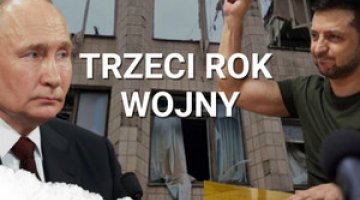Russia’s attack on Ukraine: day 165

In recent days, Russian troops have stepped up their assault in the Bakhmut area in an effort to obtain favourable positions to storm the city from the north-est and south-east. Fighting is taking place on the outskirts and in nearby villages and in the area between Bakhmut and Horlivka. The invaders are also leading an assault to the north and west of Donetsk – clashes are ongoing in the area of Novobakhmutivka, Avdiivka, Spartak, Krasnohorivka, as well as the villages of Pisky and Marinka (the Russians were expected to partially occupy both). At the same time, the Ukrainians are repelling attacks north-west of Sloviansk and on the eastern outskirts of Siversk. Hostilities are also taking place in Kharkiv Oblast (the defenders were to repel an attack in Husarivka, some 40 km north-west of Izyum) and on the border of Kherson and Mykolaiv oblasts.
The aggressor continues its increased shelling of Kharkiv, Mykolaiv, Nikopol and towns south of the Kryvyi Rih. The Ukrainians, in turn, were said to have once again shelled the Antonivka Bridge near Kherson. Both sides accuse each other of shelling residential areas in occupied Donetsk and Enerhodar, as well as the Zaporizhzhia Nuclear Power Plant (the largest nuclear power plant in Europe), which occurred on 5 and 6 August. The missiles fell directly next to a spent nuclear fuel storage facility, damaging radiation monitoring sensors. President Volodymyr Zelensky called the attack an act of terror and called on Western countries to tighten sanctions against Russia. The Russian defence ministry, meanwhile, blamed the enemy army for the shelling and appealed to the UN to condemn Kyiv. In addition, the Ukrainian administration of the Kherson Oblast accused the Russians of militarising the bridge over the Kakhovka Hydroelectric Power Plant dam, which the invaders use to move heavy weaponry and military equipment into right-bank Ukraine.
British sources report that Russia has amassed 25,000 troops in the Kherson Oblast (of which 10,000 occupy positions on the right bank of the Dnieper) with the intention of encircling Mykolaiv and is continuing to reinforce this grouping. In contrast, the Ukrainian army reports that the enemy has redeployed additional forces to the Davydiv Brid road junction (in the north of the Kherson Oblast, on the junction with the Mykolaiv Oblast) and Kherson (including 203mm Pion self-propelled cannons). The increase in military capabilities in the south is a reaction to the announcement of a Ukrainian counter-offensive. It is possible that the Russian side is planning a pre-emptive strike towards Mykolaiv or Zaporizhzhia.
Secretary of the National Security and Defence Council (NSDC) Oleksiy Danilov called for restraint in spreading information about an imminent counter-offensive by Ukrainian troops and criticised ‘couch experts’ claiming that the defenders would take Kherson in the near future. In a similar vein, Deputy Defence Minister Hanna Maliar called the public discussion of the possible directions of the Ukrainian offensive the ‘eleventh cardinal sin’, bringing harm to the army and undermining the credibility of the state’s information policy. In turn, Deputy Prime Minister Iryna Vereshchuk called on residents of the Kherson and Zaporizhzhia oblasts to evacuate as soon as possible, motivating this by preparing for a counter-offensive.
The Ministry of Defence of North Macedonia confirmed the transfer of four SU-25 assault aircraft to Kyiv (the machines were purchased in 2001 from Ukraine). Early on, the authorities in Skopje were to provide the invaded state with T-72 tanks, the number of which has not been made public (the Macedonian army is equipped with 31 tanks of this type). Adviser to the head of the President’s Office Oleksiy Arestovych announced that Iran had handed over 46 combat drones to the Russian army, which are already expected to operate in Ukraine and be used to neutralise US HIMARS missile systems. The Iranian Space Agency (ISA) denied that the ‘Khayyam’ satellite there would be used by the Russians for intelligence surveillance in Ukraine. It will be launched on 9 August by a Russian ‘Soyuz’ rocket taking off from the Baikonur cosmodrome.
There has been a change in the position of head of the collaborationist regional administration in Kherson. Volodymyr Saldo, who headed it, was taken to a hospital in Crimea and later to Moscow due to a rapid deterioration in his health. Russian media did not rule out that Saldo had been poisoned. His duties were taken over by Sergei Yeliseyev, who served in the FSB until 2005, later serving, among other positions, as a federal inspector overseeing the North-Western Federal District and, from July 2021, as deputy prime minister of the Kaliningrad Oblast government. In occupied Nova Kakhovka, the deputy head of the collaborationist administration, Vitaly Hura, was fatally wounded. The circumstances of the incident indicate that he was killed by a Ukrainian sabotage group.
In the occupied territories of the Kherson and Zaporizhzhya Oblasts, the collaborationist authorities continue to face great difficulties in preparing annexation pseudo-referenda and accelerating Russification. A final date for the plebiscite has still not been set. Two dates are given – 11 or 15 September – and the ‘vote’ is expected to last seven days. In Enerhodar, in order to create a list of those eligible to take part, the data of electricity consumers was used, without the knowledge of those concerned. In the occupied part of the Kherson Oblast, people exchanging roubles for hryvnias began to be detained. People who are paid pensions and social benefits in Russian currency are being forced under threat of withdrawal to apply for a Russian passport. Another way to speed up passportisation is to force it on those who apply to extend their land leases. Refusal to accept citizenship will result in the expropriation of leaseholders and the ‘nationalisation’ of their property.
The collaborationist authorities plan to resume schooling from 1 September. However, Ukrainian pedagogues are standing in the way, massively rejecting the offer to cooperate with the occupation. In an effort to replace them, a campaign has been launched to recruit Russian teachers to be posted to work in the occupied territories. A similar situation is taking place in the health service – due to staffing problems, it has been announced that more than 100 doctors will come from the Russian Federation to work in the Kherson Oblast. Commenting on the situation in the occupied territories, President Zelensky said that if pseudo-referendums were held there, Russia would shut down any possibility of negotiations with Ukraine, and Ukrainians who helped organise them would face criminal liability.
Ukraine’s Defence Minister Oleksii Reznikov announced that at the end of July he had dismissed the heads of the largest state-owned companies specialising in the trade of arms and military equipment – Ukrspeceksport and Spectechnoeksport. After Russia launched its invasion, these entities were excluded from the state concern Ukroboronprom and placed under the direct supervision of the defence ministry. In recent months, both companies have been tasked with importing weapons and military equipment for the Ukrainian Armed Forces, National Guard and territorial defence. The resignations were directly influenced by the dissatisfaction of the defence minister, who pointed out that, despite the transfer of more than 14 billion hryvnias (about $380 million) for arms imports, deliveries had not been made and some contracts were considered "unreliable".
According to the Ukrainian interior ministry, since the beginning of the invasion, more than 1,600 people cooperating with the Russians have been detained and more than 100 enemy sabotage groups have been dismantled. The aggressor’s services are still making efforts to receive data on the dislocation of enemy units, checkpoints and the effectiveness of Russian shelling. The Security Service of Ukraine (SBU) revealed that back in March, it detained former deputy head of military intelligence Valentyn Romanenko on suspicion of co-operating with the invaders. At the time, he was working for the State Space Agency of Ukraine. Investigators claim that he was recruited because he displayed a positive attitude towards Russia, formed during his studies at Moscow’s Frunze Military Academy. Romanenko then provided enemy services with information on the situation in the defence ministry, intelligence services and Ukraine’s defence industrial complex.
On 7 August, four vessels carrying Ukrainian agricultural products (nearly 170,000 tonnes) left the ports of Odesa and Chornomorsk, followed two days earlier by three vessels carrying 57,000 tonnes of cargo. This was made possible by an agreement signed in Istanbul on 22 July to unblock maritime transport from three Ukrainian ports. The infrastructure ministry hopes that the ports will eventually ship 100 vessels with up to 3 million tonnes of cargo per month.
Ukraine’s energy minister, Herman Halushchenko, has announced that gas consumption in the country has fallen by 40% as a result of Russian aggression. For this reason, the government is considering reducing planned stocks of the fuel in underground storage facilities before the start of the heating season (it was not specified how much this would be). At present, they amount to 12 billion m3, and according to the current government decision, the state-owned company Naftohaz should accumulate 19 billion m3 of fuel.
According to calculations by Kyiv’s Centre for Economic Strategy, Ukraine’s foreign partners have pledged nearly $34 billion of support since the start of the war, of which $12.7 billion had been received by the end of July. Only a third of the funds are to be provided in the form of grants, the rest being low-interest loans. The EU ($10.1bn) and the US ($10bn) have pledged the most aid, along with the European Investment Bank ($2.3bn) and the World Bank ($2.1bn).
Commentary
- The Ukrainian authorities are once again signalling problems with the coherence of information policy. Confusion is caused by the media activity of those commenting on the military situation without taking into account the position of the General Staff. It inspires unjustified optimism about the possibility of quickly defeating the enemy’s troops. Kyiv is aware of the difficult situation at the front, so it tries to avoid building a message based on reports of imminent victory – it recognises that this could cause public disappointment and lower morale. Calls by the National Security and Defense Council of Ukraine or the defence ministry to limit commentary on military issues mean that, despite the ‘war censorship’ in place, the media space has not been dominated by the state apparatus and may disrupt the authorities’ information policy.
- Revealed data on irregularities in companies responsible for the purchase of weapons and military equipment testify to the weakness of the cadres managing this important sphere of the economy in wartime conditions. It is possible that the cause of the disruptions are corruption procedures that are out of the control of the authorities responsible for combating this type of crime. Another factor that could negatively affect the state of Ukraine’s military capabilities is the activity of Russian agents. The detention by the SBU of a former deputy head of military intelligence passing secret information to the enemy has raised the question of the scale of Russian infiltration of state institutions. The authorities, recognising this problem as a major threat to Ukraine’s security, a few weeks ago initiated a vetting of law enforcement and secret service personnel to assess their performance in the face of aggression.
- It is still difficult to predict how stable Ukrainian agricultural exports by sea will prove to be. Since 1 August, 10 ships have set sail carrying a total of more than 300,000 tonnes of cargo. If the number of shipments of the last few days continues, it may be possible to reach exports of 3 million tonnes per month, as declared by government representatives. However, the willingness of shipowners to send their vessels to the area where hostilities are taking place will remain an open question. So far, all vessels that left Ukrainian ports under the agreement signed in Istanbul had entered there before 24 February and had remained blocked since then. According to available information, only one ship from outside had entered the Ukrainian port by 8 August.




